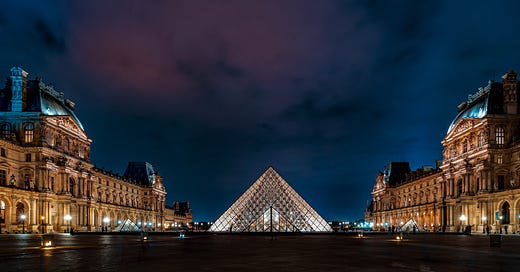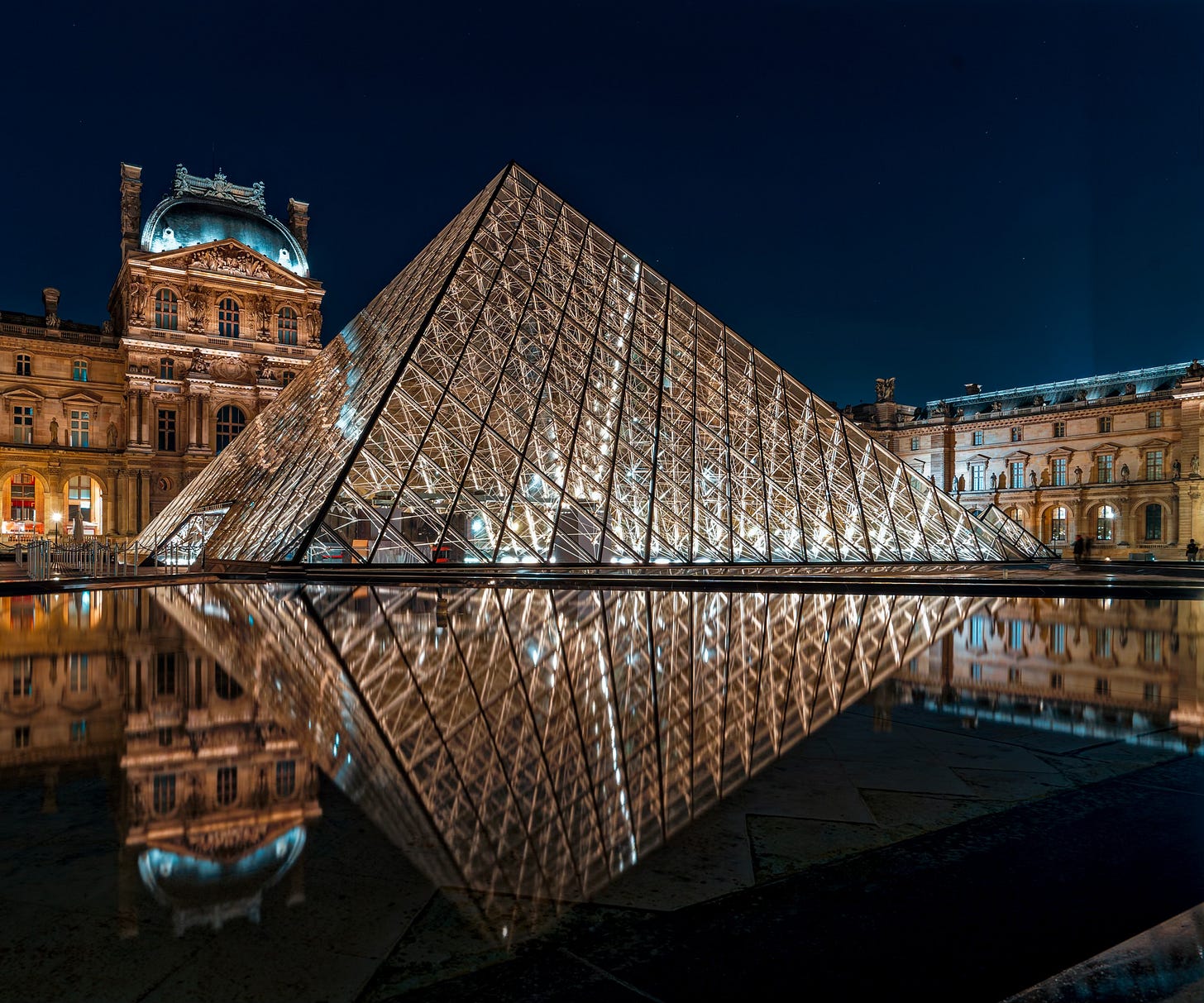Louvre Pyramid, Paris - Is I. M. Pei's grand vision way ahead of its time?
Why are we continue to talk about "in keeping" when designing new structures adjacent to old or heritage buildings?
“…why we continue to engage in architectural style and culture wars when envisioning our neighbourhoods.”
Credit must be given to France, particularly the late French president, Francois Mitterrand, for his decision to commission a foreign architect in I. M. Pei, an American Chinese, to design and renovate the iconic Louvre Museum in Paris. The proposal involved the installation of futuristic glass pyramids in the museum's central courtyard, serving as its entrance. This bold move, made in 1983, during the advent of the Hi-Tech era in architecture, divided opinions among Parisians.
While we may now view this design with indifference, it is important to remember the context of the time. The architectural landscape was undergoing a transformation, with modern buildings embracing technological advancements in construction materials. Paris had already set a precedent in blending modern architecture with historical settings through the Pompidou Centre, located just a few miles away.
As a teenager, I had the privilege of visiting the Louvre, unaware of its cultural significance and The Grands Projets of Francois Mitterrand. This architectural program aimed to symbolise France's contributions in art, politics, and the economy at the turn of the 20th century. The programme included notable monuments such as the Arab World Institute by Jean Nouvel, the Opera Bastille by Carlos Ott, and influenced the decisions regarding the Musee d'Orsay, Parc de la Villette, and La Defense.
The impact of these projects in the French capital has indirectly ignited a friendly rivalry with London and the UK regarding their cultural influence. I suspect that this rivalry has played a role in the commissioning of several Millennium Projects in the UK, such as the Millennium Dome, the London Eye, Tate Modern, the Millennium Bridge, and the Eden Project, aimed at celebrating the turn of the century.
Like many tourists, I found myself visiting the bustling Louvre Museum during the summer months, surrounded by visitors from all corners of the world jostling to catch a glimpse of the various paintings and artworks housed within this labyrinth of art and culture. My initial reaction upon seeing the central glass pyramid was one of astonishment, as it presented a stark contrast to the historical buildings that enveloped the central courtyard. However, as I delved deeper, I realised that this modern structure served as a perfect counterbalance to the museum's inherent seriousness, offering a refreshing and accessible experience to the general public.
The presence of this contemporary architectural marvel seemed to dismantle the perceived barriers of high culture that often surround museums. Its lightweight, transparent steel and glass composition created a captivating vista from a distance, acting as a landmark that enticed passersby to explore further and the architecture to entice you to capture the memory. I can recall the moment my father presented me with my first SLR film camera before the trip, encouraging me to capture anything that caught my interest. Little did I know then, but I was instinctively drawn to documenting the architectural form of these glass pyramids and the intriguing relationship they shared with their surroundings.
During my visit to Paris, I found myself amidst the peak tourist season, where every nook and cranny of the museum was occupied by eager visitors. This bustling atmosphere made it incredibly challenging to capture the meaningful photographs that I had envisioned. Moreover, being at the early stages of my photography journey, my knowledge and skillset were limited, and I had yet to grasp the intricacies of using specialist equipment like a tilt-shift lens, filters or a tripod.
Upon developing the photos, I realised that I still had a long way to go before I could produce anything remotely decent. I also had been naive to assume that I would have ample opportunities to return to Paris and refine my craft, specifically capturing the grandeur of The Louvre in a manner that did it justice.
Although I did manage to revisit Paris on a few occasions, I never succeeded in capturing high-quality photos. It wasn't until the advent of digital photography that everything changed. With the ability to capture images on a memory card instead of film, coupled with the advancements in post-processing software like Photoshop and Lightroom, the possibilities for manipulation expanded exponentially. Tasks that were once confined to the darkroom could now be accomplished with a simple click of a button or a slide of a slider, all from the comfort of one's home.
Suddenly, the need for expensive photographic equipment or access to a darkroom became obsolete. The progress in photographic technology, such as high megapixel sensors and wide-angle lenses, combined with the power of computing and sophisticated image manipulation software, surpassed anything we could have imagined during the heyday of film photography. Additionally, the availability of online tutorials has demystified the learning curve, making it easier for aspiring photographers to enhance their skills and capture stunning architectural photos.
I had the privilege of visiting Paris once the COVID pandemic subsided and travel became feasible. My accommodation was conveniently situated near the Les Halles area, just a short distance from Musée du Louvre. To avoid the bustling crowds, I decided to explore the museum in the late evening when it was closed, yet still illuminated. The experience was nothing short of surreal as I strolled along Rue De Rivoli, catching a glimpse of the captivating glass pyramid that effortlessly commanded attention. Venturing through the underpass and into the main courtyard, I was greeted by the awe-inspiring sight of this magnificent shining structure nestled within the confines of this historic institution.
The art of capturing these architectural marvels is deceptively simple, particularly with the absence of a large crowd that would otherwise complicate the process. By employing the long exposure technique and utilising digital photography, I can blend multiple images in post-production, resulting in the desired shots I have envisioned. While conventional architectural photographers may strive for pristine, people-free compositions, I find that incorporating a few silhouetted figures adds a sense of scale and vitality to the overall aesthetic of the photograph.
Despite experimenting with various angles and vantage points, the symmetrical nature of these structures imposes limitations on what I consider to be a well-balanced composition. While my photographs may not possess ground-breaking originality, they effectively convey the narrative of juxtaposing the ultramodern with classical architecture.
Considering that this design was conceived over 40 years ago, it serves as a testament to the harmonious coexistence and mutual enhancement of modern and traditional architecture. Moreover, it highlights their ability to convey distinct narratives of progress, reinvention, and reflection on the past, while also inviting and embracing the new within established institutions. It has always perplexed me why there persists an ongoing culture war between proponents of modern and traditional classical architecture.
The key to crafting an alluring urban environment lies in the fusion of well-designed streets and public spaces, infused with a sense of care. This notion of "care" holds immense significance as it profoundly shapes the definition of the urban landscape. Simply put, a poorly designed neighbourhood cannot be salvaged solely by the presence of classical buildings. Conversely, a meticulously planned modern structure, executed with the utmost care, can seamlessly coexist with historical edifices, as exemplified in this case.
The lingering question that demands an answer is why we continue to engage in architectural style and culture wars when envisioning our neighbourhoods.
Thank you for taking the time to read this. I would greatly appreciate it if you could provide any comments or feedback you may have. If you are finding this content enjoyable, why not share it with someone you know who may also find it interesting? Your support is truly valued.
My photographs are published on Instagram and online. Additionally, I am available for private commissions and collaborations with other organisations. Please do not hesitate to reach out to me for further inquiries or opportunities.







